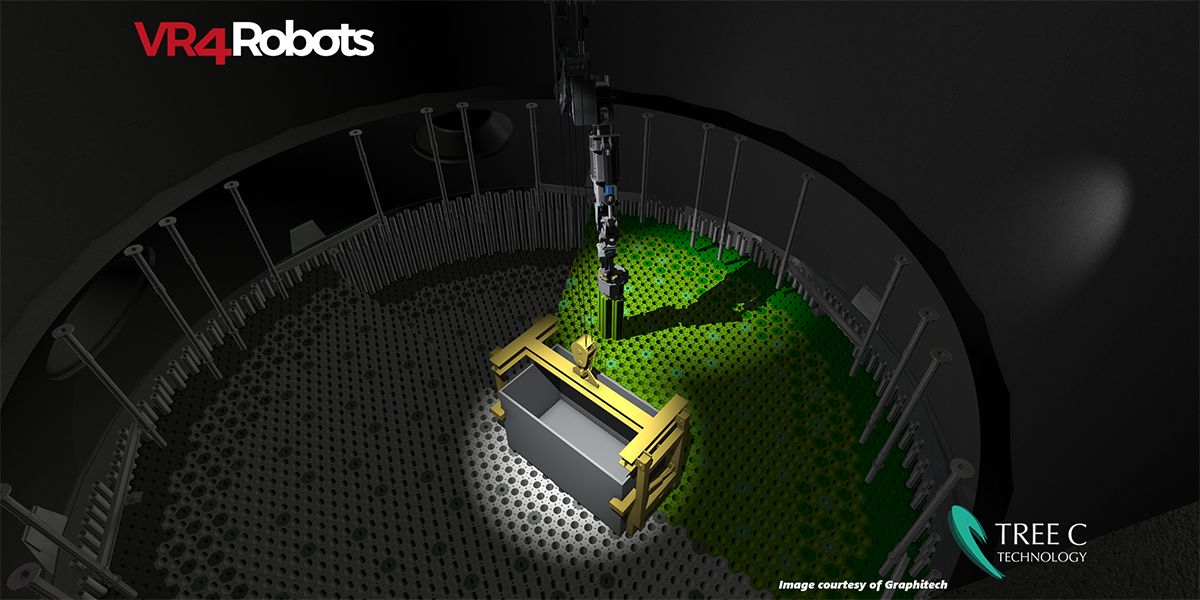6 Ways To Analyze Remote Handling Operations Using Digital Twins

Reduced visibility caused by darkness, poor camera vision, or other environmental factors can seriously impede remote handling operations. One solution is to use digital twins to replicate both physical assets – such as robots – and the real environments they’re operating in – like the seabed or a nuclear reactor.
Our visualization technology – VR4Robots – enables companies to recreate the equipment and site and then test each step of the remote operation to validate them in a realistic environment. But there are other, lesser known ways to use digital twins to analyze your operations. Let’s take a closer look at 6 ways of using digital twins in remote handling.
1 Developing Robots
CAD tools can only take the design and development of your robot so far. The only way to truly know if something works is to test it. That inevitably means building prototypes. The benefit of using digital twins is that you need fewer prototypes – saving you time and money.
Adjustments to prototypes or real-world equipment can be highly expensive. Bringing a digital twin to your design and development phase gives you a platform for trying out new equipment, analyzing the design, and quickly testing and refining it before investing in a prototype. You can get closer to the final piece of machinery before prototyping it.
2 Connecting Control Software
In the context of remote handling of robotic systems, control software is often tailor-made and customized to the application at hand. VR4Robots provides a generic interface to connect with any such custom and tailor-made piece of control software.
With this approach, the virtual robots listen to the same input and can perform the exact same tasks as the real robots. This is the main purpose of VR4Robots as a live monitoring tool for remote handling operations.
The flexibility of this approach provides the added opportunity to test the control software before connecting it to real (prototype) equipment. Movements of multiple robots can be created and evaluated in VR prior to testing the software on the real equipment. When the control software requires sensory input to complete the control loop, VR4Robots can simulate the required sensors to perform this task.
Instead of running the risk of real expensive collisions, the virtual accidents are free of charge. This is the main purpose of VR4Robots as a task and engineering validation tool for remote handling operations.
3 Monitoring Strain
When you’re developing a robotic arm, it’s important to test the strain on different pistons when lifting a payload. Simulating real-world physics, VR4Robots enables you to monitor and visualize strain at every step of a maneuver, and take deflection into account. You can even switch gravity on or off to calculate the compensation needed to correctly position the arm.
With digital twins, you can reliably and safely test out real-world activity to ensure that everything is working as intended. In fact, you can monitor the force acting on any part of the mechanism at any given moment, and this data can be presented alongside the simulation in the form of a plotted graph.
4 Dynamic Measuring
No one wants to be the person responsible for damaging expensive equipment, especially not in hazardous environments. The costs in terms of time, money, and safety can be enormous. With dynamic measuring, it’s possible to set parameters within the simulator to issue warnings that could help avoid potential collisions.
Dynamic measuring tells the simulator to stop working when a movement goes beyond stated parameters. Used alongside real-world operations, it helps the operator of a robotic arm know when to make the necessary adjustments.
This feature is also commonly used in the design phase to analyze where clearance is dangerously low. It also allows you to define the acceptable reach of a robotic arm and put constraints on its working area. That’s important when arms are set up to work safely, quickly, and autonomously – with minimal human involvement. It also protects against the human errors likely to arise from completing a highly-repetitive task.
5 Cross-Sectional Views
Getting your mechanics in perfect working order during the design and development phase is imperative for saving time and money. VR4Robots gives you total visibility over your robotics by offering cross-sectional views of the mechanics.
This view of the equipment enables engineers to analyze the inner workings of a robotic arm which would otherwise be obscured from view, particularly how they respond to a particular payload or in particular environmental conditions.
6 Sequencing Movements
In live operations, a digital twin can be used by operators with limited visibility to accurately locate the current position of robotic equipment, and plot where it will go next within a real-world physics simulator.
The movement command is entered into the simulator first to reveal important insights into clearance. This informs operators about where they need to pay special attention in order to avoid damaging equipment or slowing operations.
Putting You In Control Of Digital Twins
For engineers, the great thing about creating and working with digital twins inside VR4Robots is that the learning curve is much flatter – weeks or months – compared with a CAD software package, which can take years. That means after an initial training session from Tree C, you’ll be up and running in no time.
Discover how digital twins from Tree C can benefit your remote handling operations. Contact us